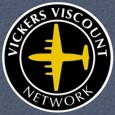
July 1973 to January 1984
British Airways (BA)
G-AOYO - c/n 264 - a V.806 series Viscount
United Kingdom registered
31 July 1973
Transferred from Northeast Airlines due to a corporate merger.
The trading name of ‘British Airways’ was formally adopted at this time, however the full merger of it’s forming companies (BEA, BOAC, Cambrian Airways and Northeast Airlines) did not take place until 1 April 1974 when BEA formally ceased to exist and the entire Viscount fleet became part of the new British Airways Regional Division.
The full integration of pilots and remaining aircraft from the previous fleets did not occur until 1 April 1976. Some Viscounts had small ‘British Airways’ titles applied to the forward lower fuselage from mid 1973 and for the former BEA Type 802 fleet the ‘BEA’ part of the main upper fuselage titling was painted over, leaving only 'Scottish Airways' or 'Channel Islands'. After September 1973 the main titling on the upper fuselage was painted over with ‘British Airways’ and the former operating division or company (Channel, Scottish, Cambrian or Northeast) was applied to most aircraft as a small title to the lower fuselage adjacent to the propellers.
Also during September 1973 the first aircraft to be painted in the new British Airways (BA) corporate livery appeared that also included the 'Cambrian' or 'Northeast' small title to the lower fuselage adjacent to the propellers for ex Cambrian and Northeast aircraft. These were retained past the mid 1970s.
There followed a period of several months where 22 of the 33 Viscounts transferred to British Airways were gradually painted in the new British Airways livery. The remaining 11 Type 802 aircraft retained the basic BEA livery with ‘British Airways’ main titling and ‘Channel’ or ‘Scottish’ sub-titling until retired in 1975/76.
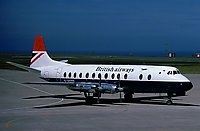
British Airways (BA)
'New' livery
1 April 1974
Northeast Airlines officially became part of BA – British Airways Regional Division.
Continued to operate on the ex Northeast Airlines routes, initially in the basic yellow livery with 'British Airways' titles and small 'Northeast' titles on the forward lower fuselage.
13 June 1975
Noted repainted in the new British Airways (BA) livery.
5 September 1979
Total time 34,424:44 hours and 31,262 total landings.

Repairs were done
at Dalcross Airport
10 January 1980
Starboard undercarriage leg failed to extend during a landing at Dalcross Airport, Inverness, Scotland. This resulted in curled propellers and shock loaded Rolls-Royce Dart engines on the starboard side.
The initial repairs were done at Dalcross Airport including replacement starboard propellers and engines. Once complete it was flown to Abbotsinch Airport, Glasgow, Scotland with its gear locked down for further repairs and returned to service.
Total time 34,917:59 hours and 31,977 total landings.
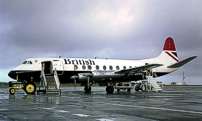
British Airways (BA)
'British' livery
circa 1981
Painted in the British Airways (BA) 'British' livery.
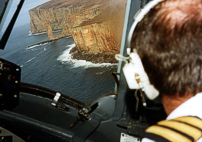
Beating up the 'Old Man of Hoy', Kirkwell, Scotland
27 and 28 March 1982
British Airways (BA) operated special flights from Abbotsinch Airport, Glasgow, Scotland to Kirkwall Airport, Orkney Islands, Scotland with Viscounts G-AOYL (C/N 261), G-AOYM (C/N 262), G-AOYO (C/N 264) and G-APIM (C/N 412), to mark the airline's withdrawal of the type twenty-five years after it had first visited Kirkwall and following twenty years of scheduled services. Three hundred passengers, many of whom were British Airways (BA) air crew and ground crew, past and present, took part in the occasion, which included a celebratory dinner and dance at Kirkwall.
The instigator and chief organiser of this very popular and fondly remembered event was Jack Ridgway, who was to serve for nearly twenty years as BEA - British European Airways and British Airways (BA) Station Manager at Kirkwall airport. Hundreds of spectators watched as the four aircraft departed at lunchtime on Sunday 28 March, each making a low flypast of the airport and the town.
28 March 1982
Operated the last service for British Airways (BA) from Kirkwall Airport, Orkney Islands, Scotland to Abbotsinch Airport, Glasgow, Scotland.
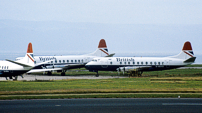
Stored at Rhoose, Cardiff, Wales
8 April 1982
Ferried to Rhoose Airport, Cardiff, South Glamorgan, Wales, withdrawn from service and stored.
Total time 36,926 hours and 34,546 total landings.
27 January 1984
Sold to British Air Ferries (BAF).
 FURTHER READING: Books about British Airways (BA) FURTHER READING: Books about British Airways (BA)
|

